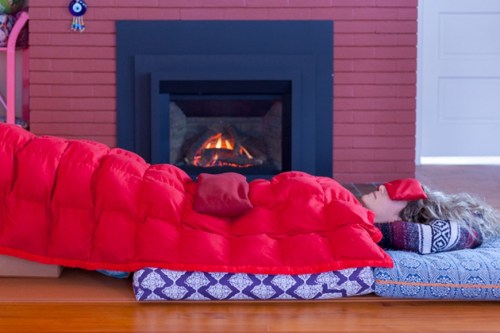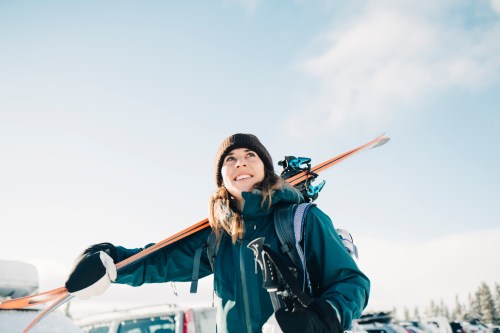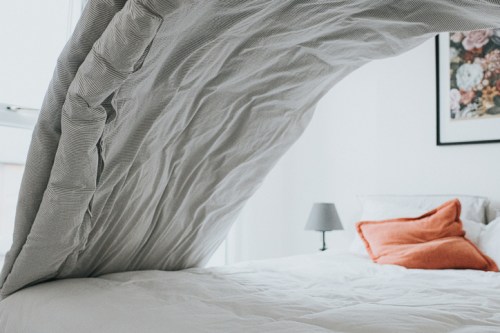On the list of ways to unwind, there are few things that sound as relaxing as staying under the covers or taking a super-chill restorative yoga class. So, imagine what it would be like to combine the two? That’s basically the concept behind Kambal Yoga, a new form of the ancient practice, which Stephanie O’Hanlon Kayalar, RN, created to help cultivate more chill vibes in her own life—and those of the students who come to Restore Balance, her integrative wellness center in Glen Falls, NY.
Kambal is a Hindi word that means a blanket or shawl made of coarse wool commonly worn in India. This unique practice utilizes 12-pound blankets—which are essentially full-body sized with one side made out of cotton and the other of micro channeled fleece squares—along with other props (such as bolsters, sandbags, and eye pillows), to passively hold poses without stress to the body. Kayalar, who’s a certified restorative yoga teacher, says she came up with the idea after reading that wearing weighted vests at school helped kids calm down. “I wanted to see how it worked with clients, so I started using weighted blankets during class. The response was like night and day.”
Deep pressure touch, which the blankets promote, can help reduce anxiety and lower levels of the stress hormone, cortisol, according to research. (Kayalar is currently working with Dr. Jennifer Bremser, a researcher at SUNY Plattsburgh to study the scientific benefits of Kambal.)
Intuitively, though, it makes sense. Think of how good you feel whenever you get into bed and pull up the comforter (I mean, the name alone says it all)—it’s like suddenly all is right in the world, right?
The weight doesn’t feel as though the walls are closing in; it sort of hugs you like when your mother tucked you in snug and safe.
And while everything thus far sounds pretty much the same as any hygge night at home wrapped up in a big blanket, here’s what the practice is actually like: Kambal combines body scanning, yoga nidra (a guided meditation done while lying down), restorative poses, reiki, massage, and inspirational readings.
“I focus on creating a nurturing and safe environment for people to slow down, listen to themselves and work through emotions in a non-invasive, gentle way,” Kayalar says. “We have a limited time here [on Earth], a limited time with the ones we love, so my hope is to teach people that they can be present for more of their moments with others, that we can stop trying to change everything and just find peace with what is and what has been.”
I can attest to the chill-ax effect the class had on me. The first pose is always a reclining bound angle (more on that below). The blanket covers you from around your chest to your toes, an eye pillow is placed on your face and sandbags anchor your upward facing palms to the ground. The weight doesn’t feel as though the walls are closing in; it sort of hugs you like when your mother tucked you in snug and safe. As I was lying there listening to my body, opening my heart, and finding my breath, I discovered that ever elusive inner balance I so truly crave. Something else I learned my heart desires? Having another excuse to stay under the covers.
Read on for 4 super-restorative blanket yoga moves you can do at home.

To start a Kambal Yoga practice at home, you can get the same weighted blanket used in class (or layer a few chunky ones of your own to create a similar effect). Once you’re comfy in each of the moves below, place the covers on top of your body so you’re covered from neck-to-toe.
1. Lean back
Do a bolstered savasana (AKA a reclining bound angle). “Lie on your back with a [regular] blanket or towel underneath your head and put [another one] underneath your knees, allowing your toes to fall out and your heels to come in and relax,” instructs Kayalar.
2. Get a leg up
Lie your back on the floor facing your sofa or a chair. Place your legs up on the cushion so that your knees are in a 90 degree angle and you end up in a relaxing inversion. “I believe any time our backs and head are flat on the ground and our eyes are closed, we start to immediately calm,” says the yogi. “Any form of home meditation is helpful, even if for only five minutes, particularly listening first to how our thoughts sound and then not judging them but letting them pass and coming back to our breathing.”
3. Get twisted
Do a bolstered restorative twist: “Turn to your right side, rest your head and shoulders on a bolster (or body pillow) in a slightly reclined position and have your arms straddling the bolster,” Kayalar says. “Then after a few minutes switch to the left side.”
4. Weighted savasana
Just like how you would end a standard flow by lying on your back, you want to hit ultimate relaxation as the finale in this restorative yoga practice, too. “Lie flat on the ground, palms facing up,” Kayalar says. (Don’t forget your eye pillow!)
Sign Up for Our Daily Newsletter
Get all the latest in wellness, trends, food, fitness, beauty, and more delivered right to your inbox.
Got it, you've been added to our email list.










